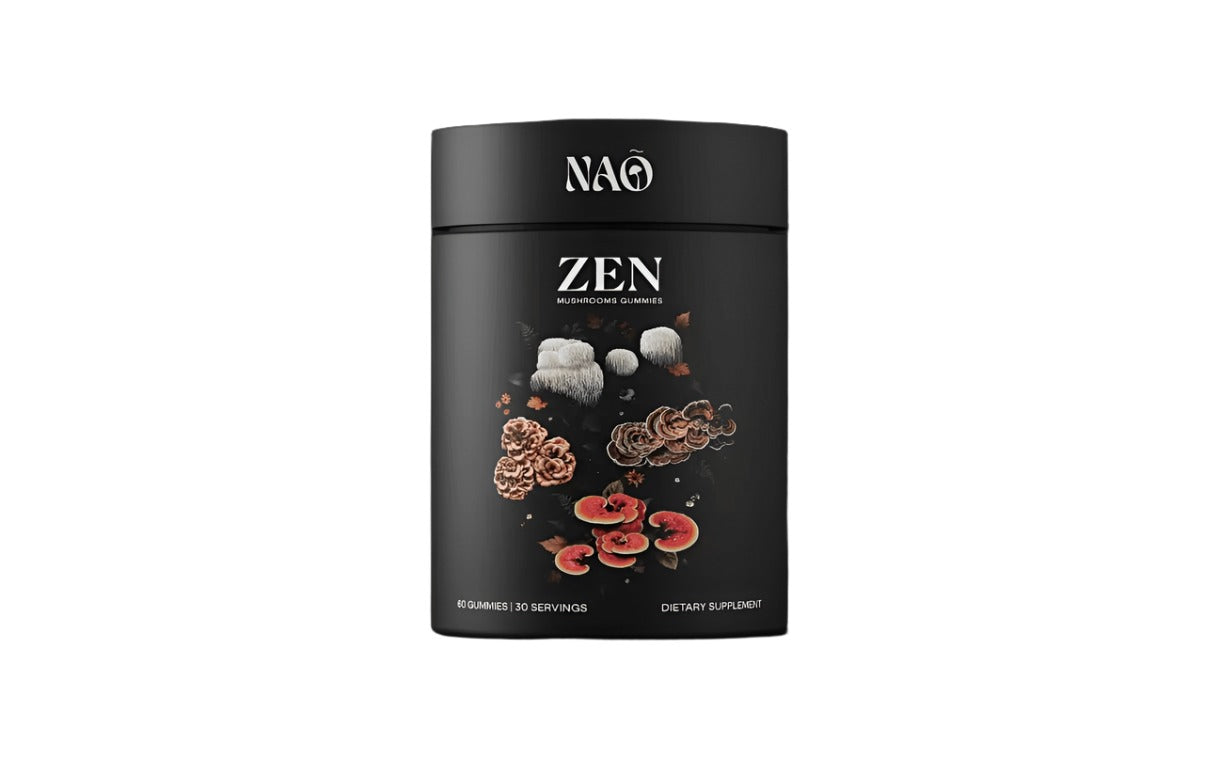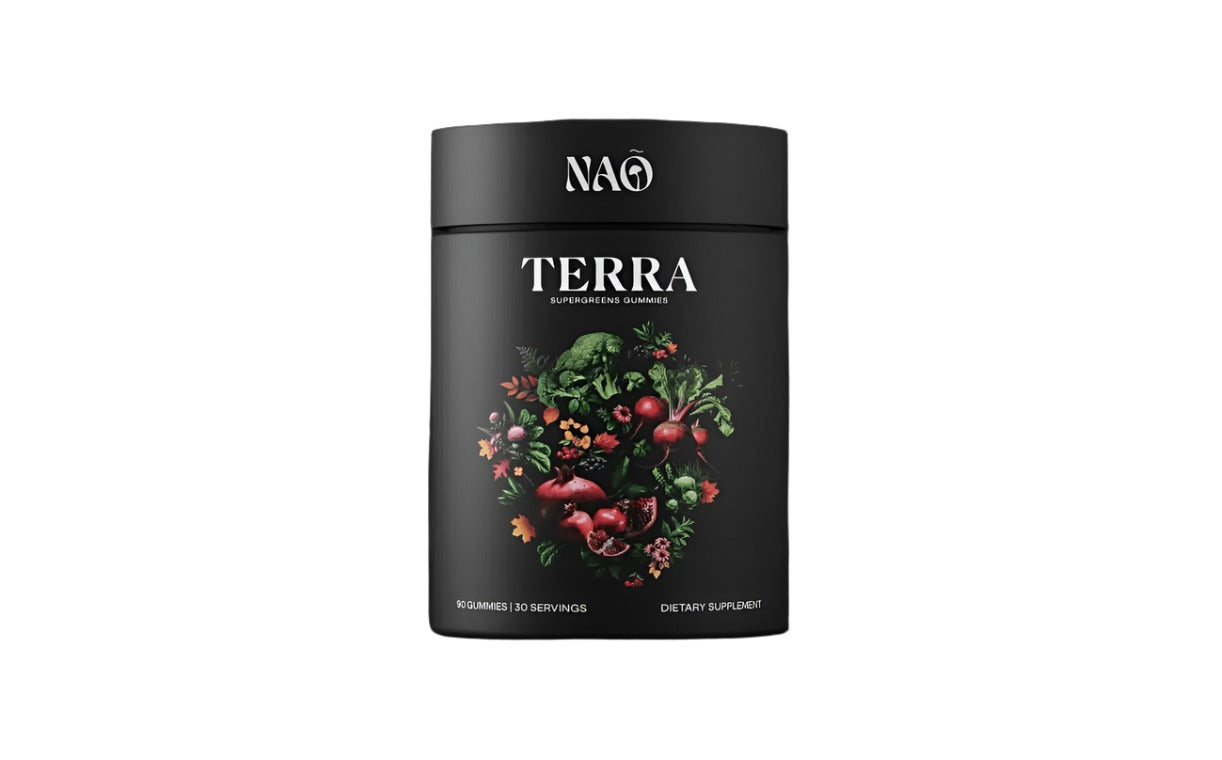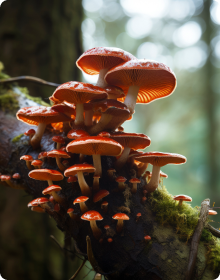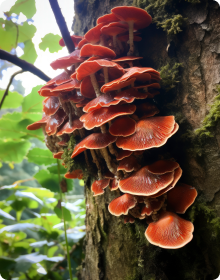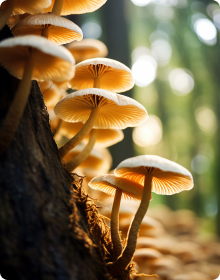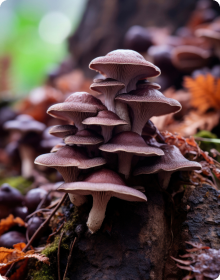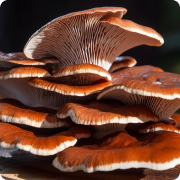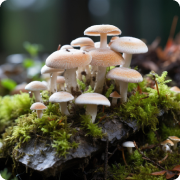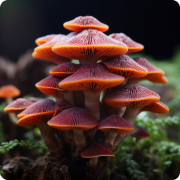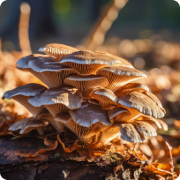What are Chaga Mushrooms? Benefits,Usage and Recommendations
Chaga mushrooms, scientifically known as Inonotus obliquus, have garnered increasing attention for their potential health benefits and traditional uses. This article is dedicated to the broad research of these unique and helpful representatives of microworld.
Definition and Brief Overview of Chaga Mushrooms
Chaga mushrooms are a type of fungus that primarily grows on birch trees in cold northern climates. Recognized by their specific dark appearance, Chaga mushrooms are not typical culinary mushrooms. Instead, they are valued for their potential medicinal properties.
The scientific community has taken a keen interest in Chaga mushrooms due to their unique composition. These fungi contain a variety of bioactive compounds, including polysaccharides, polyphenols, and beta-glucans, which contribute to their potential health-promoting effects.
Historical Significance and Traditional Use
Chaga mushrooms have a rich history steeped in traditional medicine. Indigenous peoples in Siberia, Canada, and other northern regions have been using Chaga for centuries to address various health concerns. In traditional Siberian folklore, Chaga was often referred to as the "King of Herbs" or the "Gift from the Gods" due to its perceived potent healing properties.
Historically, Chaga mushrooms were prepared as teas or extracts and consumed to promote overall well-being. Traditional uses include addressing digestive issues, boosting energy levels, and supporting the immune system. These practices have laid the foundation for the modern exploration of Chaga mushrooms as a potential health supplement.
Understanding Chaga Mushrooms
Before diving into deep research, let`s first understand the essence of this kind of mushroom.
Identification and Characteristics
Chaga mushrooms are easily recognizable by their unique appearance. Typically found as a black, charcoal-like mass on the bark of birch trees, Chaga boasts a hard, crusty exterior that resembles burnt wood. Internally, it displays a vibrant orange hue due to the presence of high concentrations of a pigment called betulinic acid, derived from the birch trees on which it grows.
Natural Habitat and Distribution
Chaga mushrooms thrive in cold climates and are commonly found in regions with subarctic temperatures, including Siberia, Alaska, and northern Canada. The birch trees serve as their natural habitat, and Chaga establishes a symbiotic relationship with these trees. The mushrooms draw nutrients from the birch trees, contributing to their unique nutritional composition.
Nutritional Composition
Chaga mushrooms are rich in various bioactive compounds, making them a potential powerhouse for health benefits. The nutritional composition includes polysaccharides, beta-glucans, polyphenols, and triterpenes. These components contribute to Chaga's antioxidant, anti-inflammatory, and immune-boosting properties, making it a subject of interest for those seeking natural ways to support their well-being.
Chaga Mushroom Health Benefits
Contemporary research has focused on extracting and studying the bioactive compounds present in Chaga mushrooms. Different studies suggest that Chaga extracts may possess antioxidant and anti-inflammatory properties. And can contribute to our health in a few ways.
Liver Health and Disease Prevention
Some studies suggest that Chaga mushrooms may play a role in supporting liver health and preventing liver diseases. The antioxidants presented in Chaga are believed to help protect the liver from damage caused by free radicals.
Powerful Antioxidant Properties
Chaga mushrooms are renowned for their powerful antioxidant properties. Antioxidants help combat oxidative stress in the body, neutralizing free radicals that can contribute to various health issues, including chronic diseases and aging.
Immune System Support
The bioactive compounds found in Chaga mushrooms, such as beta-glucans, may contribute to immune system support. These compounds have been studied for their ability to enhance the activity of immune cells, promoting a more robust defense against infections and illnesses.
Anti-Inflammatory Effects
Chaga mushrooms exhibit anti-inflammatory effects, which can be beneficial for individuals dealing with inflammatory conditions. By reducing inflammation, Chaga may help alleviate symptoms associated with conditions like arthritis or inflammatory bowel diseases.
Potential Cancer-Fighting Properties
Several studies suggest that Chaga mushrooms may possess compounds with anti-cancer properties.
Benefits for Skin Health
Chaga mushrooms may also offer benefits for skin health. The antioxidants and anti-inflammatory properties could contribute to a healthier complexion.
Active Compounds in Chaga Mushrooms
All these health benefits would be impossible if chaga wouldn`t comprise several active compounds:
- Beta-Glucans: beta-glucans are polysaccharides that play a crucial role in supporting the immune system. They can modulate and enhance the immune response, potentially helping the body defend against infections and diseases.
- Polysaccharides: polysaccharides are complex carbohydrates made up of multiple sugar molecules. In Chaga Mushrooms, polysaccharides contribute to the mushroom's immune-modulating properties and may have antioxidant effects.
- Triterpenes: triterpenes are a class of organic compounds known for their diverse biological activities. In Chaga Mushrooms, triterpenes exhibit anti-inflammatory properties and may contribute to the fungus's potential anti-cancer effects.
- Melanin: melanin is a pigment responsible for the dark color of Chaga Mushrooms. It has antioxidant properties and is believed to protect the mushroom from environmental stressors, potentially offering similar benefits when consumed by humans.
These compounds collectively contribute to the various health-promoting properties that were previously described, such as skin care properties, antioxidant effects, etc.
Chaga mushroom consumption ways
Chaga mushrooms can be consumed in various forms, and their usage has been adapted to different cultural and personal preferences. Here are common methods of consumption and usage of Chaga Mushrooms:
- One of the most traditional ways to consume Chaga is by making a tea or infusion. To prepare this tea, chunks of dried Chaga are often simmered in hot water for an extended period, extracting the bioactive compounds into the liquid. The resulting tea can be consumed hot or cold.
- Chaga tinctures involve extracting the active compounds of Chaga using alcohol or a combination of alcohol and water. Tinctures are concentrated liquid extracts that can be added to water or other beverages for easy consumption. This method is preferred by some individuals who want a more potent and convenient way to incorporate this mushroom into their routine.
- Chaga mushrooms can be dried and ground into a powder. This powder can be added to smoothies, soups, stews, or other recipes to enhance nutritional content. This method provides a versatile way to include Chaga in daily meals.
- Chaga supplements, usually in the form of capsules, offer a convenient way to incorporate Chaga into a daily routine. These supplements contain Chaga extract or powder in a concentrated form, providing a standardized dosage.
- Some companies produce Chaga-infused coffee or beverages, combining the benefits of the mushroom with the familiar taste of coffee or other drinks. These products are designed to offer a more palatable option for those who may not enjoy the taste of traditional Chaga tea.
- Chaga extracts are concentrated forms of mushroom, often obtained through a dual extraction method (combining hot water and alcohol extraction). These extracts may come in liquid form or as a paste and can be added to various foods and beverages.
It's only up to you in which way to consume the mushroom.
Scientific Research and Studies of Chaga Mushroom Benefits
Numerous studies have explored the bioactive compounds and potential health benefits of Chaga mushrooms. Researchers have focused on the antioxidant, immunomodulatory, and anti-inflammatory properties of Chaga. Despite promising findings, some studies may have limitations such as small sample sizes or the need for more extended follow-up periods.
Clinical Trials and Their Implications
While there is growing interest, the number of clinical trials on Chaga mushrooms is relatively limited compared to preclinical studies. Some clinical trials have investigated Chaga's effects on immune function, inflammation, and oxidative stress. Ongoing research aims to elucidate the optimal dosage, duration, and safety profile of Chaga supplementation.
While there is a growing body of scientific research supporting the potential health benefits of Chaga mushrooms, ongoing and future clinical trials will provide more definitive insights into its therapeutic effects, optimal usage, and safety profiles.
Exploration of Chaga's Potential in Cancer Prevention and Treatment
As was said before, Chaga mushrooms have also gained attention for their potential role in cancer prevention and treatment due to their bioactive compounds. Preclinical studies have investigated the anti-cancer properties of Chaga, including its ability to inhibit the growth of cancer cells and induce apoptosis (programmed cell death). The presence of triterpenes, polysaccharides, and other compounds in Chaga is of interest in understanding its potential anti-cancer mechanisms.
While animal studies have shown promising results, the translation of these findings tohuman cancer treatment is still in the early stages. Ongoing research aims to uncover the specific mechanisms by which Chaga may impact cancer cells and whether it can be integrated into conventional cancer treatments. Clinical trials exploring Chaga's role in cancer prevention, adjunctive therapy, or mitigating side effects of cancer treatments are essential for establishing its clinical significance. Collaboration between oncologists, mycologists, and researchers is crucial to advancing our understanding of Chaga's potential role in cancer care.
Precautions and Potential Side Effects of Chaga Mushrooms
Despite its safety for most people, there are still some considerations which must be taken into account before chaga consumption.
- Allergic Reactions: Allergic reactions can range from mild symptoms, such as skin rashes, to more severe reactions like difficulty breathing.
- Interaction with Medications: Chaga mushrooms may interact with certain medications, affecting their absorption, metabolism, or excretion. People taking anticoagulant or antiplatelet medications should be cautious, as Chaga may have mild blood-thinning effects. And individuals with diabetes should monitor their blood sugar levels, as Chaga may influence blood glucose levels.
- Safe Dosage Guidelines: The optimal and safe dosage of Chaga is individual and can vary based on factors such as an individual's health status, age, and overall well-being. So, as a general guideline, starting with a lower dosage and gradually increasing while monitoring for any adverse effects is advisable.
- Duration of Use: Periodic breaks in consumption or consulting with a healthcare professional for guidance on long-term use must be considered because the long-term safety of Chaga hasn`t been researched properly yet.
- Pregnancy and Breastfeeding: Pregnant or breastfeeding individuals should exercise caution when considering Chaga supplementation. Limited research exists on the safety of Chaga during pregnancy and lactation, so consulting with a healthcare provider is the best option.
- Monitoring for Adverse Effects: Incorporating Chaga into their routine should be monitored for any adverse effects such as gastrointestinal discomfort, allergic reactions, or changes in medication effectiveness. If adverse effects occur, discontinuing Chaga use and seeking medical advice is recommended.
Expert Recommendations and Tips
As has been previously said, dosage recommendations for Chaga can vary, but starting with a lower dose and gradually increasing allows individuals to assess their tolerance. Standard dosage recommendations may range from 500mg to 2000mg per day, but individual responses can vary.
In terms of integrating Chaga into a Holistic Wellness Routine you should take next steps:
- Consultation with a Healthcare Professional (if you have pre-existing health conditions, are taking medications, or are pregnant or breastfeeding).
- Consideration of Individual Goals (understanding individual wellness goals can guide the incorporation of Chaga into a routine).
- Quality Sourcing (look for reputable suppliers that provide information about sourcing, testing, and certifications).
- Variety of Consumption Methods (tea, powder, capsules, etc.).
- Consistency in Use (consistency is key when integrating Chaga into a routine, regular use over time may be more beneficial than sporadic consumption).
- Complementing a Healthy Lifestyle (chaga should be viewed as part of an overall healthy lifestyle that includes a balanced diet, regular physical activity, and other wellness practices).
- Holistic Approach to Wellness (integrating Chaga into a holistic wellness routine involves considering various aspects of health, including mental, emotional, and physical well-being).
Exploring the multifaceted world of Chaga mushrooms reveals a wealth of potential benefits that contribute to overall health and well-being. From its rich array of bioactive compounds, including beta-glucans, polysaccharides, triterpenes, and melanin, to its traditional uses spanning centuries across various cultures, Chaga has captured the attention of both traditional practitioners and modern researchers.
Recapping the benefits, we find that Chaga exhibits antioxidant properties, supports the immune system, and may have anti-inflammatory and potential anti-cancer effects. Scientific research, though in its nascent stages, showcases promising findings that warrant further exploration and clinical investigation.
Whether incorporated as a soothing tea, a tincture, or a supplement, Chaga offers versatility in consumption, allowing individuals to tailor its usage to their preferences. Dosage recommendations, although varying, emphasize the importance of gradual integration and monitoring for individual responses.
As research continues to unfold, and as more individuals incorporate Chaga into their daily lives, the potential benefits of this remarkable mushroom beckon exploration. The tale of Chaga mushrooms is one of traditional meeting science, offering a tapestry of possibilities for those seeking a natural and holistic approach to health.
